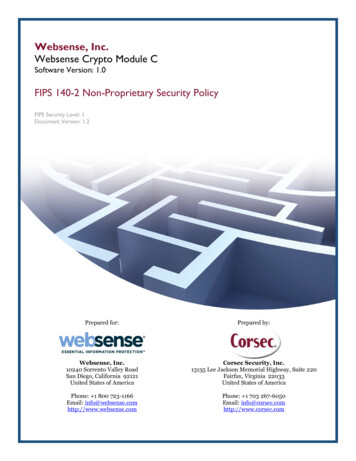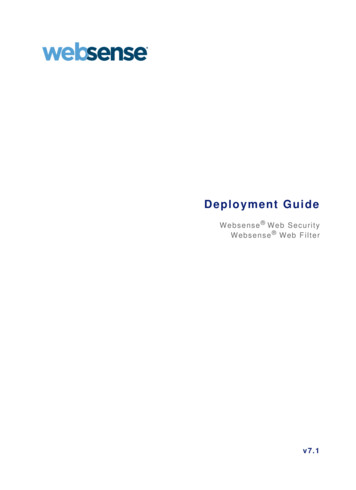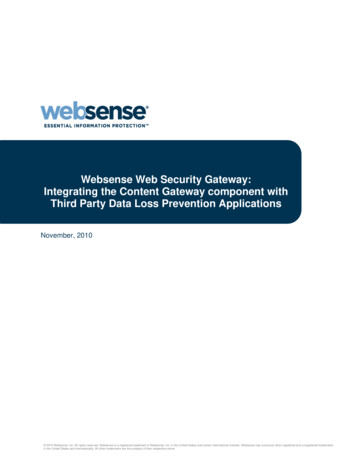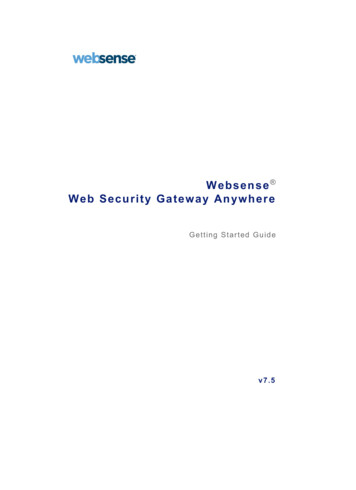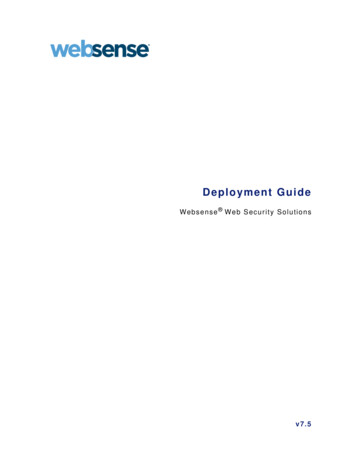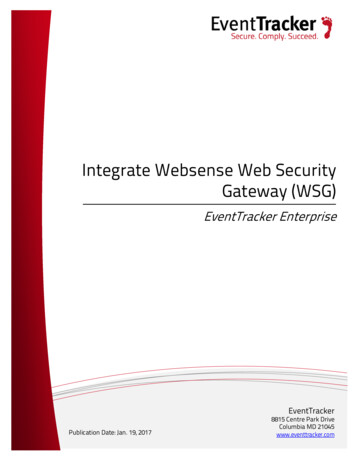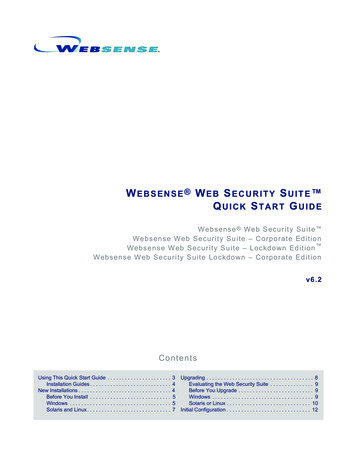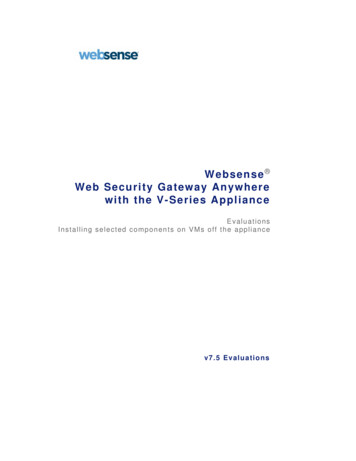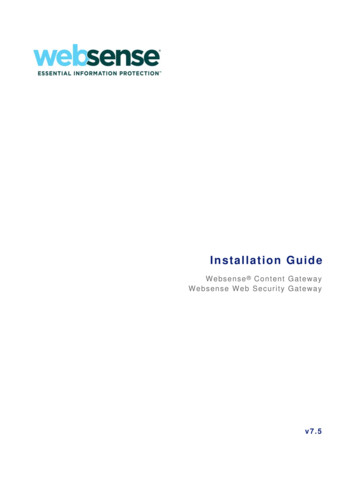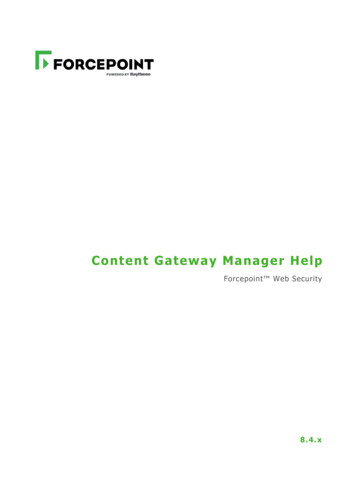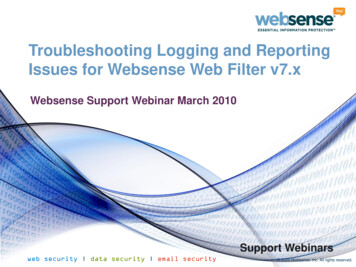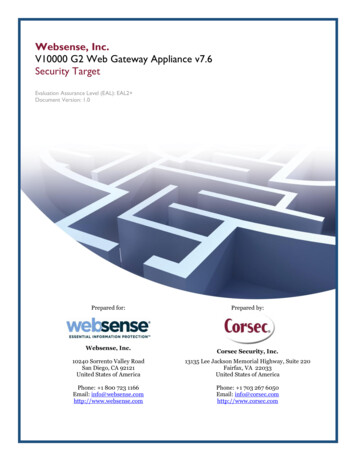
Transcription
Websense, Inc.V10000 G2 Web Gateway Appliance v7.6Security TargetEvaluation Assurance Level (EAL): EAL2 Document Version: 1.0Prepared for:Websense, Inc.Prepared by:Corsec Security, Inc.10240 Sorrento Valley RoadSan Diego, CA 92121United States of America13135 Lee Jackson Memorial Highway, Suite 220Fairfax, VA 22033United States of AmericaPhone: 1 800 723 1166Email: info@websense.comhttp://www.websense.comPhone: 1 703 267 6050Email: info@corsec.comhttp://www.corsec.com
Security Target, Version 1.0December 22, 2011Table of Contents1INTRODUCTION . 41.1 PURPOSE . 41.2 SECURITY TARGET AND TOE REFERENCES . 41.3 TOE OVERVIEW . 41.3.1 Web Proxy . 51.3.2 Traffic Filtering . 51.3.3 Policy Enforcement and Management . 61.3.4 TOE Environment . 71.4 TOE DESCRIPTION . 81.4.1 Physical Scope. 81.4.2 Logical Scope . 91.4.3 Product Physical/Logical Features and Functionality not included in the TOE . 102CONFORMANCE CLAIMS . 113SECURITY PROBLEM . 123.1 THREATS TO SECURITY.123.2 ORGANIZATIONAL SECURITY POLICIES .123.3 ASSUMPTIONS .134SECURITY OBJECTIVES . 144.1 SECURITY OBJECTIVES FOR THE TOE .144.2 SECURITY OBJECTIVES FOR THE OPERATIONAL ENVIRONMENT.144.2.1 IT Security Objectives . 144.2.2 Non-IT Security Objectives . 155EXTENDED COMPONENTS . 165.1 EXTENDED TOE SECURITY FUNCTIONAL COMPONENTS .165.1.1 Class FDP: User Data Protection . 165.2 EXTENDED TOE SECURITY ASSURANCE COMPONENTS.176SECURITY REQUIREMENTS . 186.1 CONVENTIONS .186.2 SECURITY FUNCTIONAL REQUIREMENTS .186.2.1 Class FAU: Security Audit . 206.2.2 Class FDP: User Data Protection . 226.2.3 Class FIA: Identification and Authentication. 246.2.4 Class FMT: Security Management . 256.2.5 Class FPT: Protection of the TSF . 276.2.6 Class FRU: Resource Utilization . 286.2.7 Class FTA: TOE Access . 296.3 SECURITY ASSURANCE REQUIREMENTS .307TOE SUMMARY SPECIFICATION . 317.1 TOE SECURITY FUNCTIONS .317.1.1 Security Audit . 327.1.2 User Data Protection . 337.1.3 Identification and Authentication. 337.1.4 Security Management . 347.1.5 Protection of the TSF . 357.1.6 Resource Utilization . 357.1.7 TOE Access . 358RATIONALE . 368.1 CONFORMANCE CLAIMS RATIONALE .368.2 SECURITY OBJECTIVES RATIONALE .36Websense V10000 G2 Web Gateway Appliance v7.6 2011 Websense, Inc.This document may be freely reproduced and distributed whole and intact including this copyright notice.Page 2 of 48
Security Target, Version 1.08.38.48.59December 22, 20118.2.1 Security Objectives Rationale Relating to Threats . 368.2.2 Security Objectives Rationale Relating to Policies . 388.2.3 Security Objectives Rationale Relating to Assumptions . 38RATIONALE FOR EXTENDED SECURITY FUNCTIONAL REQUIREMENTS .39RATIONALE FOR EXTENDED TOE SECURITY ASSURANCE REQUIREMENTS .39SECURITY REQUIREMENTS RATIONALE .398.5.1 Rationale for Security Functional Requirements of the TOE Objectives . 398.5.2 Security Assurance Requirements Rationale . 448.5.3 Rationale for Refinements of Security Functional Requirements . 448.5.4 Dependency Rationale . 44ACRONYMS . 479.1 ACRONYMS .47Table of FiguresFIGURE 1 - DEPLOYMENT CONFIGURATION OF THE TOE.7FIGURE 2 - PHYSICAL TOE BOUNDARY .8FIGURE 3 – EXT FDP ROL ROLLBACK OF TOE CONFIGURATIONS FAMILY DECOMPOSITION . 16List of TablesTABLE 1 - ST AND TOE REFERENCES .4TABLE 2 - CC AND PP CONFORMANCE . 11TABLE 3 - THREATS . 12TABLE 4 - ASSUMPTIONS . 13TABLE 5 – SECURITY OBJECTIVES FOR THE TOE . 14TABLE 6 – IT SECURITY OBJECTIVES . 15TABLE 7 – NON-IT SECURITY OBJECTIVES . 15TABLE 8 – EXTENDED TOE SECURITY FUNCTIONAL REQUIREMENTS . 16TABLE 9 – TOE SECURITY FUNCTIONAL REQUIREMENTS. 18TABLE 10 – ASSURANCE REQUIREMENTS . 30TABLE 11 – MAPPING OF TOE SECURITY FUNCTIONS TO SECURITY FUNCTIONAL REQUIREMENTS . 31TABLE 12 – AUDIT RECORD CONTENTS. 32TABLE 13 – THREATS:OBJECTIVES MAPPING . 36TABLE 14 – ASSUMPTIONS:OBJECTIVES MAPPING . 38TABLE 15 - OBJECTIVES:SFRS MAPPING . 39TABLE 16 – FUNCTIONAL REQUIREMENTS DEPENDENCIES. 44TABLE 17 - ACRONYMS . 47Websense V10000 G2 Web Gateway Appliance v7.6 2011 Websense, Inc.This document may be freely reproduced and distributed whole and intact including this copyright notice.Page 3 of 48
Security Target, Version 1.01December 22, 2011IntroductionThis section identifies the Security Target (ST), Target of Evaluation (TOE), and the ST organization. TheTarget of Evaluation (TOE) is the Websense V10000 G2 Web Gateway Appliance v7.6, and will hereafterbe referred to as the TOE throughout this document. The TOE is a web proxy and traffic filter with realtime threat scanning. The TOE can block or allow user traffic to various websites or protocols based on thecategorization of the website or protocol and the policies defined on the TOE.1.1 PurposeThis ST is divided into nine sections, as follows: Introduction (Section 1) – Provides a brief summary of the ST contents and describes theorganization of other sections within this document. It also provides an overview of the TOEsecurity functions and describes the physical and logical scope for the TOE, as well as the ST andTOE references.Conformance Claims (Section 2) – Provides the identification of any Common Criteria (CC),Protection Profile, and Evaluation Assurance Level (EAL) package claims. It also identifieswhether the ST contains extended security requirements.Security Problem (Section 3) – Describes the threats, organizational security policies, andassumptions that pertain to the TOE and its environment.Security Objectives (Section 4) – Identifies the security objectives that are satisfied by the TOEand its environment.Extended Components (Section 5) – Identifies new components (extended Security FunctionalRequirements (SFRs) and extended Security Assurance Requirements (SARs)) that are notincluded in CC Part 2 or CC Part 3.Security Requirements (Section 6) – Presents the SFRs and SARs met by the TOE.TOE Summary Specification (Section 7) – Describes the security functions provided by the TOEthat satisfy the security functional requirements and objectives.Rationale (Section 8) - Presents the rationale for the security objectives, requirements, and SFRdependencies as to their consistency, completeness, and suitability.Acronyms (Section 9) – Defines the acronyms and terminology used within this ST.1.2 Security Target and TOE ReferencesTable 1 - ST and TOE ReferencesST TitleWebsense, Inc. V10000 G2 Web Gateway Appliance v7.6 Security TargetST VersionVersion 1.0ST AuthorCorsec Security, Inc.ST Publication Date2011-12-22TOE ReferenceWebsense V10000 G2 Web Gateway Appliance v7.6KeywordsProxy, filter, web, protocol, V10000 G2, Websense.1.3 TOE OverviewThe TOE Overview summarizes the usage and major security features of the TOE. The TOE Overviewprovides a context for the TOE evaluation by identifying the TOE type, describing the product, anddefining the specific evaluated configuration.Websense V10000 G2 Web Gateway Appliance v7.6 2011 Websense, Inc.This document may be freely reproduced and distributed whole and intact including this copyright notice.Page 4 of 48
Security Target, Version 1.0December 22, 2011The V10000 G2 Web Gateway Appliance is a protocol filtering appliance that provides two major features:web proxy and traffic filtering. Web proxy allows the TOE to inspect web content accessed by users anddetermine if it is malicious or undesirable. Traffic filtering allows the TOE to inspect non-web traffic inorder to determine whether the traffic should be allowed or not, based on the protocol. Web proxy andtraffic filtering work together to prevent security breaches, productivity loss, and legal issues that mightarise due to inappropriate or careless browsing and network usage habits.1.3.1 Web ProxyWeb proxy offers three features to help prevent users from accessing unwanted web content: dynamicscript inspection, script filtering, and content classification.Dynamic script inspection allows the TOE to inspect scripts in real-time to determine if they contain knownmalicious code. If malicious code is found within proxy content, then the TOE can block access to thatcontent to prevent a security breach.Script filtering is used when malicious code is found within proxy content, but instead of blocking accessthe TOE removes only the malicious content. This is useful if a site contains useful content, but has beencompromised in some way, since the useful content can still be accessed while denying access to maliciousscripts. This feature is particularly applicable to Web 2.0 sites, which allow custom user-generated contentthat may include malicious code.Content classification allows administrators to use predefined or custom content classifications to block orlimit access to certain categories of content, such as adult or political websites. The default list ofcategories includes: Security Filtering – includes sites that host botnets, keyloggers, phishing scams, etc.Bandwidth Categories – includes sites that host Internet radio and television, peer-to-peer filesharing, streaming media, etc.Productivity Categories – includes sites that host advertisements, freeware and softwaredownloading, instant messaging, etc.Abortion – includes sites that host content related to abortion.Adult material – sites that contain full or partial nudity or sexual content, lingerie and swimsuitmodels, or sex education.Advocacy Groups – includes sites that promote change or reform in various aspects of publicpolicy, public opinion, social practice, economic activities, or relationships.Business and Economy – includes sites that are sponsored by or devoted to business firms,financial and investment sites, and business-oriented web applications.Drugs – sites that contain information on legal and illegal drugs.There are many other categories included in the full list. The entire list of default content categories can befound at: .In addition to the default categories, administrators can define custom categories and assign UniformResource Locators (URLs) to these categories manually. This allows easy classification of localizedcontent that may not have been classified yet by Websense.1.3.2 Traffic FilteringTraffic (or protocol) filtering works by inspecting the port of user traffic to determine if it matches one ofthe ports used by restricted protocols. If a protocol is restricted, the TOE blocks the connection. Protocolscan be included in predefined protocol groups such as: Database – protocols that enable the creation and manipulation of structured sets of information.Websense V10000 G2 Web Gateway Appliance v7.6 2011 Websense, Inc.This document may be freely reproduced and distributed whole and intact including this copyright notice.Page 5 of 48
Security Target, Version 1.0 December 22, 2011File Transfer – protocols that enable user control over the transfer of files across a network.Instant Messaging/Chat – protocols that enable sending and receiving synchronous,
Target of Evaluation (TOE) is the Websense V10000 G2 Web Gateway Appliance v7.6, and will hereafter be referred to as the TOE throughout this document. The TOE is a web proxy and traffic filter with real-
